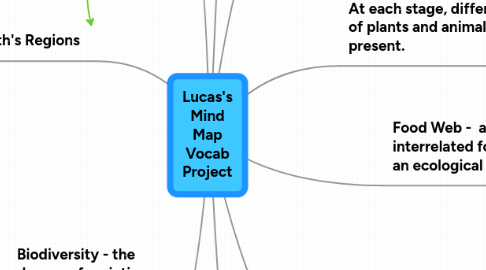
1. Earth's Regions
1.1. Tundra - a biome where plant life is hindered by low temperatures and short growing seasons.
1.1.1. Desert - a landscape or region that recieves an extremely low amount of precipitation, less than enough to support growth of plants.
1.1.1.1. Temperate deciduous forest - a forested biome found in mid-latitude temperatures and dominated by deciduous vegetation.
1.1.1.1.1. Rainforest - forests characterized by high rainfall, with diverse plant and animal life.
2. Water
2.1. Marine Biome - an aquatic biome that includes all the water on the earth's surface. It covers 3/4 of the earth.
2.1.1. Freshwater Biome - a low-saline aquatic biome thata ccounts for 1/5 of the earth's surface.
2.1.1.1. Aquifer - a geological formation that contains water.
2.1.1.1.1. Water Pollution - the contamination of water bodies.
3. Biodiversity - the degree of variation of life forms within a given ecosystem, biome, or planet.
3.1. Hotspots - a region of the earth which is extremely biologically diverse, and under severe threat due to habitat loss.
3.1.1. Biotic Factors - living factors in an ecosystem.
3.1.1.1. Abiotic Factors - non-living factors of anecosystem that affect living organisms.
4. History
4.1. Black Plague - a bubonic plage that kiled 3 million people in the 1300's. This made the population go down.
4.1.1. Industrial Revolution - a period in the 18th - 19th centuries where technology greatly increased, allowing the human population to increase as well.
5. Food Chain - a succession of organisms in an ecological community that constitutes a continuation of food energy from one organism to another.
5.1. Trophic Levels - the positions organisms occupy on a food web.
5.1.1. Producers - organisms that produce their energy from the sun.
5.1.1.1. Primary Consumers - an organism that gets its energy from eating producers.
5.1.1.1.1. Secondary Consumers - organisms that get their energy by eating primary consumers.
6. Food Web - a complex of interrelated food chains in an ecological community.
6.1. New node
7. Levels
7.1. Organism - any form of life.
7.1.1. Biome - a region of earth inhabited by a community.
7.1.1.1. Biosphere - layers of soil, water, and air that sustains life.
7.1.1.1.1. Ecosystem - a group of organisms that interact with each other and the enviornment.
8. Ecological Succession - a series of enviornmental changes thta occurs in stages. At each stage, differnt species of plants and animals may be present.
8.1. Primary Succession - succession that occurs in places that an ecosystem has never existed.
8.1.1. Secondary Succession - succession that occurs in places where an ecosystem has been damaged.
8.1.1.1. Pioneer Species - the first species to move into an ecosystem at the beginning of succession
8.1.1.1.1. Climax Community - a community at the end of succession that is in equilibrium with little or no change in species.
9. Population Growth - the change in a population over time.
9.1. Limiting Factors - a factor that controls a process, such as organism growth or species population, size, or distribution.
9.1.1. Carrying Capacity - the maximum population size of a species that an enviornment can sustain indefinitely.
9.1.1.1. Exponential Growth - when a population has a constant birth rate through time and is not limited.
9.1.1.1.1. Sustainability - when a population has the capacity to endure over time.
